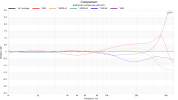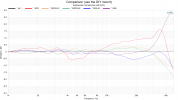Hi guys, I'm Earthworks M30 microphone user.
I have great faith in Earthworks, but I nevertheless wanted to test it at least once.
And that dream just became a reality today.
Audio lovers in Korea heard me, they sent me their Earthworks microphones without any hesitation.
And below is a picture of Earthworks family.

M23 x1, M23R x2, M30(old ver.), M30, M50
First of all, I needed a mount to hold them together fairly.
I am fully aware of how fatal the interference of the initial reflection sound is in loudspeaker/microphone measurements.
But to proceed with a measurement with one microphone stand, I need to be able to cross a total of six microphones 'completely' into the same position.
And I thought it might not be possible, so I needed a minimum safety device to measure.
So I made this mount by overlapping two 30T MDFs that have been processed by CNC.


And they put them all together.

Also, because this was only a safety device in case the measurement failed, the measurement of each microphone was made as precise as possible using a laser.


Before we look at the measurement data, let's compare the calibration files (ECFs) that we received from the owners of the microphones.

The old M30 (#1) did not have a calibration file.
Now let's take a look at the data!
I measured it by replacing each of the six microphones.
But I can't believe my own microphone replacement skills.
Therefore, I repeated this one more time to find the deviation of the setting for each microphone.

The graphs on the image above represent deviations between each microphone setting.
I measured everything from M23 to M50 once and repeated this again, so it takes a total of 6 microphone replacement steps to measure M23 and return to M23.
I was thrilled shortly after I found out that it was measured more precisely than I thought.
I was disappointed because I realized that the mount with my affection soon became useless, but the accuracy of the measurement is more important than that.

This is data calculated based on the average response(with ECF) of all microphones.

This is the data calculated based on the average response of the three microphones (M23R, M50), which are universally expected to be more sophisticated.
Similarly, the ECF was applied.

This is a calculation of the response of the remaining microphones based on the response of the flagship M50.
Below is the data in the same process as above, but this time it is calculated from the responses in the default state that did not apply the ECF file provided by the manufacturer.



I'm sorry I cut you off in the middle.
I put a lot of effort into making the mount for this measurement. I also wondered how far this was valid.
This is a comparison between a one-point measurement and a mount measurement.


It's never reliable data, but personally, it's touching just to have a similar shape.
Now it's time to look at the individual responses of each microphone.
M23

M23R #1

M23R #2

M30 #1 (old)

M30 #2

M50

Personally this is very interesting.
Finally, let's look at the sensitivity deviation and self-noise of each microphone.

All four other microphones except the M23 fit within +/- 0.5 dB.
(Of course, this is the data applied with the ECF file.)
I also got the data without applying the ECF file, but it was lost while organizing the file.
But I have the original, so I'll try to restore it as soon as possible.
+ I attached the missing data. (2023-01-05)

 audiosciencereview.com
audiosciencereview.com

This is the sensitivity deviation of two R series microphones.
You can see that there is a difference between applying and not applying ECF files.

Finally, this is self-noise measurement data.
All microphones are calibrated using the same SPL Calibrator before measurement.
This is measured in my studio, so it cannot be measured lower than the background noise in my studio.
And I recently compared the M23R and the M30, and the self-noise of the M30 measured at this time is somewhat heterogeneous.
But this time, I compared all 6 mics in the same place at once, so I believe in this data.

Thank you to the audio lovers in Korea who sent me the microphone.
+
I succeeded in remeasuring selfnoise with your help.
Thank you.

 audiosciencereview.com
audiosciencereview.com
I have great faith in Earthworks, but I nevertheless wanted to test it at least once.
And that dream just became a reality today.
Audio lovers in Korea heard me, they sent me their Earthworks microphones without any hesitation.
And below is a picture of Earthworks family.
M23 x1, M23R x2, M30(old ver.), M30, M50
First of all, I needed a mount to hold them together fairly.
I am fully aware of how fatal the interference of the initial reflection sound is in loudspeaker/microphone measurements.
But to proceed with a measurement with one microphone stand, I need to be able to cross a total of six microphones 'completely' into the same position.
And I thought it might not be possible, so I needed a minimum safety device to measure.
So I made this mount by overlapping two 30T MDFs that have been processed by CNC.
And they put them all together.
Also, because this was only a safety device in case the measurement failed, the measurement of each microphone was made as precise as possible using a laser.
Before we look at the measurement data, let's compare the calibration files (ECFs) that we received from the owners of the microphones.
The old M30 (#1) did not have a calibration file.
Now let's take a look at the data!
I measured it by replacing each of the six microphones.
But I can't believe my own microphone replacement skills.
Therefore, I repeated this one more time to find the deviation of the setting for each microphone.
The graphs on the image above represent deviations between each microphone setting.
I measured everything from M23 to M50 once and repeated this again, so it takes a total of 6 microphone replacement steps to measure M23 and return to M23.
I was thrilled shortly after I found out that it was measured more precisely than I thought.
I was disappointed because I realized that the mount with my affection soon became useless, but the accuracy of the measurement is more important than that.
This is data calculated based on the average response(with ECF) of all microphones.
This is the data calculated based on the average response of the three microphones (M23R, M50), which are universally expected to be more sophisticated.
Similarly, the ECF was applied.
This is a calculation of the response of the remaining microphones based on the response of the flagship M50.
Below is the data in the same process as above, but this time it is calculated from the responses in the default state that did not apply the ECF file provided by the manufacturer.
I'm sorry I cut you off in the middle.
I put a lot of effort into making the mount for this measurement. I also wondered how far this was valid.
This is a comparison between a one-point measurement and a mount measurement.


It's never reliable data, but personally, it's touching just to have a similar shape.
Now it's time to look at the individual responses of each microphone.
M23
M23R #1
M23R #2
M30 #1 (old)
M30 #2
M50
Personally this is very interesting.
Finally, let's look at the sensitivity deviation and self-noise of each microphone.
All four other microphones except the M23 fit within +/- 0.5 dB.
(Of course, this is the data applied with the ECF file.)
I also got the data without applying the ECF file, but it was lost while organizing the file.
But I have the original, so I'll try to restore it as soon as possible.
+ I attached the missing data. (2023-01-05)

I measured the deviation of 6 Earthworks microphones.
Doesnt take care of real performance and try to make it to hight end performance with compensation I mean you can always pay tens of thousands of dollars for a class 1 measurement microphone, but us peasants can only afford the mass produced Class 2 microphones.
 audiosciencereview.com
audiosciencereview.com
This is the sensitivity deviation of two R series microphones.
You can see that there is a difference between applying and not applying ECF files.
Finally, this is self-noise measurement data.
All microphones are calibrated using the same SPL Calibrator before measurement.
This is measured in my studio, so it cannot be measured lower than the background noise in my studio.
And I recently compared the M23R and the M30, and the self-noise of the M30 measured at this time is somewhat heterogeneous.
But this time, I compared all 6 mics in the same place at once, so I believe in this data.
Thank you to the audio lovers in Korea who sent me the microphone.
+
I succeeded in remeasuring selfnoise with your help.
Thank you.

I measured the deviation of 6 Earthworks microphones.
Doesnt take care of real performance and try to make it to hight end performance with compensation I mean you can always pay tens of thousands of dollars for a class 1 measurement microphone, but us peasants can only afford the mass produced Class 2 microphones.
 audiosciencereview.com
audiosciencereview.com
Last edited: